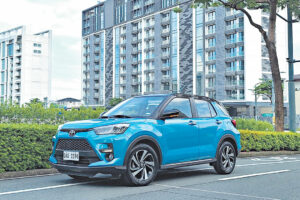By Dylan Afuang
THAT TOYOTA builds vehicles with rock-solid reliability and sells them by the millions is now a tale that’s as old as time. In the foreground, meanwhile, consumer preference has shifted from sedans and hatchbacks to high-riding, supposedly more rugged SUVs and crossovers.
The Japanese car maker responded to that industry trend with the Raize. Derived from Toyota’s partner company Daihatsu, it’s a crossover featuring SUV-inspired looks and capabilities, matched with an exterior size and pricing comparable to that of the Vios.
We explore Toyota’s answer through the model’s 1.0 Turbo CVT variant. Going for P1.063 million, the Raize Turbo features the best the model range has to offer — chief among which is a turbocharged one-liter engine.
Since the model’s 2022 launch, Toyota Motor Philippines (TMP) has also offered the Raize in E MT (P751,000), E CVT (P851,000), and G CVT (P936,000) guises, with all three models featuring a non-turbo 1.2-liter mill.
Sporting familiar Toyota design cues, such as a triangular front grille and rear windows with black panels to appear like it “wraps” around the rear quarters, the Raize holds an aesthetic distinction above its ilk from China and South Korea.
The variant-exclusive turquoise metallic color and LED headlamps certainly enhance the car’s appearance, too. Ensuring that the Raize looks and rides over uneven terrain as close to a true off-roader as possible are the car’s upright body shape and ground clearance of 200mm. Large door apertures and raised seats grant easy access to the cabin.
The dashboard layout is similar to that in the Wigo, Yaris Cross, Avanza, and Veloz. Controls dotted around the dashboard are easy to find and operate, and the generous amount of leg-, shoulder-, and headroom for all five occupants are matched with plenty of storage provisions, and a sizable 369-liter cargo area that can be expanded by the split-folding rear bench.
Notable equipment of the Raize Turbo includes part-leather seats, remote locking and push-button start, fully digital instruments with configurable displays, steering-wheel controls, dual USB ports, and an Android Auto and Apple CarPlay-compatible nine-inch touchscreen infotainment with six-speaker sound system.
These features compensate for the few interior foibles. The plastics used on the doors and dashboard feel low-rent, perhaps in a bid to save production costs and to lower SRP, while the seamless device input for the infotainment is not matched with crisp audio output.
Well worth the car’s P1-million asking price is that one-liter, three-cylinder mill sourced from the Wigo, but with a turbocharger bumping the output to 97hp and 140Nm of torque. Mated to a CVT that drives the front wheels, engine performance is adequate — not breakneck as the “turbo” moniker would suggest — for pretty much any driving condition.
What the turbo and smooth gearbox do are assist the engine gain and maintain speed easily, so as to achieve fuel economy figures of above 10kpl in the city and almost 20kpl on the highway. “Easy” also encapsulates the Raize’s driving dynamics, helped by a light steering feel, good visibility outward the expansive windows, and a relatively fine ride and acceptable NVH levels.
On top of parking sensors, the Raize Turbo has blind-spot and front-clearance sensors that sound an alert when motorbikes or people enter the vehicle’s blind areas. This variant is also outfitted with side air bags, while standard on all Raize models are stability control and hill-start assist.
Commercial success didn’t meet the Raize just because it’s a crossover and of Toyota’s stellar reliability record. If its Turbo variant is any indication, the vehicle’s merits, such as decent levels of performance and equipment, make it an acceptable product of the times.
